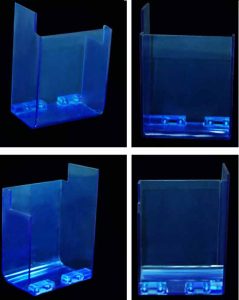Product Categories
Product Tags
Manufacturing of acrylic prototypes
Machined, silicone vacuum overmolded PMMA prototype
In the prototype industry, acrylic, also known as PMMA, is a transparent prototype material. Acrylic prototypes are mainly made by cnc processing. Acrylic has a relatively good transparency effect, which can reach 95% of the light transmittance.
Machined, silicone vacuum overmolded PMMA prototype
In the prototype industry, acrylic, also known as PMMA, is a transparent prototype material. Acrylic prototypes are mainly made by cnc processing. Acrylic has a relatively good transparency effect, which can reach 95% of the light transmittance.
Disadvantages of acrylic prototype:
Everyone knows that glass is very brittle, and acrylic is a kind of plexiglass. Therefore, its physical properties are also very brittle, and the shortcoming of poor toughness causes the acrylic to break accidentally. In the process of prototyping, this is the focus of attention. If the machining process cannot be completed, it can only be replaced with other materials, such as PC.
Advantages of acrylic prototype:
The important thing is high transparency. After polishing, the transparency can achieve the effect of full transparency. This effect is called plexiglass in the industry, which is unmatched by PC materials. Although PC is also transparent, the effect is not as good as that of acrylic.

CNC machined acrylic prototype shell
Contact Us
Waiting for your email, we will reply you within 12 hours with valuable information you needed.
 English
English العربية
العربية 中文(漢字)
中文(漢字) Čeština
Čeština Dansk
Dansk Nederlands
Nederlands Suomi
Suomi Français
Français Deutsch
Deutsch Italiano
Italiano 日本語
日本語 ಕನ್ನಡ
ಕನ್ನಡ 한국어
한국어 Português
Português Русский
Русский Slovenčina
Slovenčina Español
Español Svenska
Svenska Türkçe
Türkçe


